
Atlas F1 Technical Writer
Jaguar Racing have clearly recovered in 2003 from their frequent management and engineering upheavals, and for the first time since Ford purchased the Stewart team and renamed it Jaguar, the team shows clear signs of moving forward. Atlas F1's Technical Writer Craig Scarborough attended the team's 2004 launch earlier this week at Barcelona, Spain, and took a closer look at the R5
At the start of the design process for the 2003 car (the R4), the new technical and management structure was founded to resolve the design problems encountered on the dreadful R3. Hence, the R4 was developed directly from the R3, taking care to design out its failings, in a methodical and conservative manner.
With the R3's history and the approach to the R4, Jaguar became the surprise package in 2003, apparently adapting to the new qualifying rules with a car capable of reaching the front rows of the grid.
Working in a low-risk, conventional fashion has seen the team stabilise from the 'reinventing the wheel' philosophy that had gone before. Only development that was truly understood has been included in the new car; solutions that gave measurable gain without sufficient explanation were held back for further examination.
This conservative approach saw the car ready before Christmas, whereupon a program of non-track tests was carried, such as 7-poster rig testing and straight-line tests.
The Car
Based almost entirely on the R4 aero concept, the team's "understand and then develop" philosophy is evident in the bodywork. Some of the car's layout has been altered to create more potential and a major gain has been found in the detail shape of the monocoque, however outwardly similar it appears, retaining its single keel.
The sidepod shaping is more evolved than on first impression. The sidepod's fronts are higher and flatter-faced, and they sweep back to a very low and waisted rear. This fact is partly obscured by the hot air outlet. While this outlet does provide more of an obstruction to the flow along the flanks of the sidepods, aerodynamicist Ben Agathangelou stated he was happy with the compromise, as they understood how the solution worked - whereas other solutions cannot be so easily proven.
One of the key design features of the outlet is it moulds very closely to the radiators - which are mounted almost longitudinally - allowing it to collect most of the heated flow and direct it out over the rear tyres. Combined with the exhaust fairing, there is little requirement for additional outlets, making the rear of the car all the more slimmer.
While wings and bargeboard are all interim items before a Melbourne spec has been decided on, a new rear wing was installed for the troublesome shake down laps, using a mild 3D shape just taking the edge of the strength of the tip vortices in order to reduce drag.
Agathangelou also explained that the bi-plane arrangement (two lower, one upper element) - or cascade set up, as he described it - was not necessarily dead by only having two elements to play with. He added it had some benefits that could see a true bi-plane layout (one upper, one longer lower) but still a multi-element wing is inherently more efficient.
The Engine
Development started early on the new derivatives and the resulting CR6 - to be supplied to Jordan as well as Jaguar - has seen the necessary development work completed to their satisfaction. Even the 72-degree unit provided to Minardi has a new CR3-L (for Long Life) specification.
Cosworth have been juggling the opposing needs of low weight, power and reliability. The engine has remained conceptually the same, with size largely unaltered despite it being an all-new engine. However, the compromise found for the opening three flyaway races is not going to be consistent with the strategy over the balance of the year. In fact, many teams are opting for safer designs to capture easy points in the crucial opening races.
The Mechanics
What was again surprising was the lack of visible concept change around the car. The gearbox is an all-new casting with a neater and lower layout; the rear suspension still uses three coil springs over new Koni dampers, in place of the previous Penske units. Directly above these is the gearbox oil cooler, still fed from the main engine airbox - a practice eschewed by the rest of the grid.
Towards the front, the suspension layout adopts the increasingly common drooped front suspension layout, with the upper wishbones pointed downwards from the chassis towards the wheel. As Williams have adopted this strategy it may have something to do with how the Michelin tyres react to the camber change as the wheel moves up and down.
The detail around the front bulkhead remains familiar with a neat power steering rack and three dampers set up. Brake ducts are a new development, with a shroud around the peripheral vents in the disc, directing the flow towards the outer face of the wheel.
While Pi continues to develop the electronics and no real information being forthcoming, one critical interface between the driver and car is the ergonomics in the cockpit. To assist the team, Lear Corporation continues to develop the seat and pedal layout. This year they also make the seat belts.
Having kept the same simple steering wheel moulding with fairly rudimentary controls, this year the team have turned to the Jaguar road car division to develop a more friendly shape and control system, resulting in a totally new steering wheel.
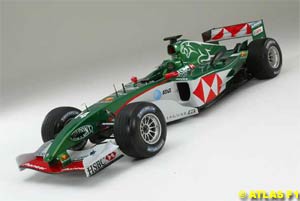 Since buying the Stewart team, a succession of unstable management saw the now named Jaguar team leap from crisis to crisis, as well from conventional to radical to conventional car. Some level of control was regained by owners Ford in 2003, as the newly appointed management rebuilt the Formula One organisation into an effective and mature team. Adopting a methodical approach, Jaguar are now seeing the results. And, even if the new R5 would not be topping the time sheets, this conservative but well understood design is the bedrock on which future success will be built.
Since buying the Stewart team, a succession of unstable management saw the now named Jaguar team leap from crisis to crisis, as well from conventional to radical to conventional car. Some level of control was regained by owners Ford in 2003, as the newly appointed management rebuilt the Formula One organisation into an effective and mature team. Adopting a methodical approach, Jaguar are now seeing the results. And, even if the new R5 would not be topping the time sheets, this conservative but well understood design is the bedrock on which future success will be built.
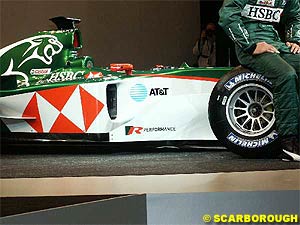 While the qualifying performances were headline hitting, their race performances were not quite so strong, often ending in a slowing of pace or retirement. What the team discovered was the car wore its rear tyres too quickly and also suffered on heavy fuel loads. No true solutions were found during the year, but Head of Vehicle Performance Dr Mark Gillan now says they were able to identify and resolve these problems during winter testing.
While the qualifying performances were headline hitting, their race performances were not quite so strong, often ending in a slowing of pace or retirement. What the team discovered was the car wore its rear tyres too quickly and also suffered on heavy fuel loads. No true solutions were found during the year, but Head of Vehicle Performance Dr Mark Gillan now says they were able to identify and resolve these problems during winter testing.
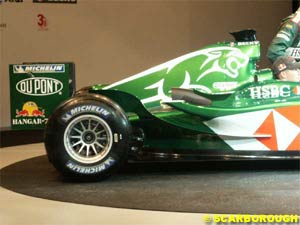 The car's format has changed, with the sidepods moved back as part of the common direction in F1 design. The splitter has a flat iron shaped bulge to house ballast to tune the car to around 46-48% weight towards the front.
The car's format has changed, with the sidepods moved back as part of the common direction in F1 design. The splitter has a flat iron shaped bulge to house ballast to tune the car to around 46-48% weight towards the front.
 Moving on to the engine cover, the small airbox allows the bodywork to remain narrow over the engine, ending with an open vertical cut at the Axle line. Although the abrupt end of the cover could cause problems - creating vortices when the car yaws, upsetting the rear wing - Agathangelou said this was a concern but with so many other surfaces in yaw, the negative effect of this is limited.
Moving on to the engine cover, the small airbox allows the bodywork to remain narrow over the engine, ending with an open vertical cut at the Axle line. Although the abrupt end of the cover could cause problems - creating vortices when the car yaws, upsetting the rear wing - Agathangelou said this was a concern but with so many other surfaces in yaw, the negative effect of this is limited.
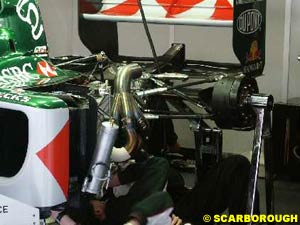 As a supplier, Cosworth provided three different engines to three teams in 2003 (Jaguar, Jordan and Minardi) with only the Jaguar one a truly new engine. Considering this fact it was a disappointing year for Cosworth reliability-wise, with several failures for the teams every race weekend. Nick Hayes from Cosworth accepted this fact but added that only once was there a repeated failure, all the other problems being isolated cases. Yet, going into the 800Km one-engine rule for 2004 doesn't worry the supplier.
As a supplier, Cosworth provided three different engines to three teams in 2003 (Jaguar, Jordan and Minardi) with only the Jaguar one a truly new engine. Considering this fact it was a disappointing year for Cosworth reliability-wise, with several failures for the teams every race weekend. Nick Hayes from Cosworth accepted this fact but added that only once was there a repeated failure, all the other problems being isolated cases. Yet, going into the 800Km one-engine rule for 2004 doesn't worry the supplier.
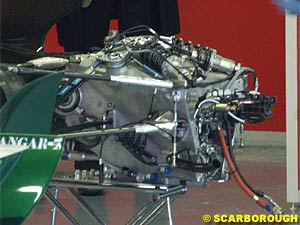 Unusually for a team launching their car, Jaguar were quite open when working on the car in the Barcelona pit earlier this week, and during the enforced engine\gearbox change it was possible to see the detail layout of the mechanical parts.
Unusually for a team launching their car, Jaguar were quite open when working on the car in the Barcelona pit earlier this week, and during the enforced engine\gearbox change it was possible to see the detail layout of the mechanical parts.
Please Contact Us for permission to republish this or any other material from Atlas F1.
|
Volume 10, Issue 3
Articles
A Farewell to Arms?
Technical Analysis: Toyota TF104
Technical Analysis: Jaguar R5
Interview with Ron Tauranac
2004 Countdown: Facts & Stats
Columns
The Fuel Stop
The F1 Trivia Quiz
On the Road
Elsewhere in Racing
> Homepage |